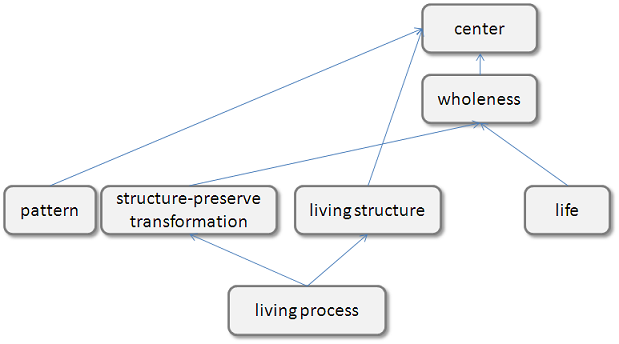
最終更新日 : 2011/4/13 (2011/4/7 より執筆開始)
下滝 亜里 <asatohan at gmail.com>
内容に関するコメント(感想、提案、書き間違いの指摘)は歓迎します。
疑問に答える
全体像を教えて

アレグザンダーは何をしようとしたの?
My aim in this book is to create a scientific view of the world in which this concept -- the idea that everything has its degree of life -- is well-defined.その他。
[...] The key idea in this book is that life is structural. [...]その他。
As I use it, the term "living" applied to structure is always a matter of degree. Strictly speaking, every structure has some degree of life. The main accomplishment of Book 1 is in making this distinction precise, in providing empirical methods for observing and measuring degree of life as it occurs in different structures. Perhaps most important, I gave in Book 1 a partly mathematical account of living structure, so that we may see the content of living structure, its functional and geometric order, as an established and objective feature of reality.その他。
I state this by means of the following hypothesis: What we call "life" is a general condition which exists, to some degree or other, in every part of space: brick, stone, grass, river, painting, building, daffodil, human being, forest, city. And further: The key to this idea is that every part of space -- every connected region of space, small or large -- has some degree of life, and that this degree of life is well defined, objectively existing, and measurable.
wholenessとかcenterとかって何で知らないといけないの?
In order to understand life as a phenomenon, it is necessary to define something which I call "the wholeness" and also certain crucial entities which I call "centers", the building blocks of whoneless. [...]
wholenessって何なの?
I define the wholeness W as the system which is created by the region R, together with the measure c and all those subregions which have measure more than some threshold and thus qualify as centers. For all practical purposes, the wholeness W is created by the interaction of the geometry of the region R and the rank order which is created on the centers of R by c.このことからは、wholenessを分かるには、いくつかのものが必要なことが分かる。
ついでに他の言い方も載せておく。
The wholeness W, is a feature of physical space which appears everywhere, in every part of matter/space.物理空間(physical space) って書いてる点に注意が必要じゃないかな。
アレグザンダーの例と同じのを使って簡単に補足する。
まず、R の例。本文ではパターン R と呼ばれている。

7つの四角からなる。3つが黒で4つが白ね。
Siの例。27=128のサブ領域があるとしている。全部載せられないからいくつかだけ。

wholenessの観点からいうと、全てのサブ領域が重要なわけじゃない。どうでもいいのもある。なので、そういうのを取り除く。どういうのかっていうと、接続されていない領域(100個)と一つだけの領域(7個)。アレグザンダーによると、これらは、wholnessにおいて重要な役割を果たすcenterとしては弱すぎるから、ってことらしい。で、具体的には以下のやつ。接続されていない領域のは、100個全部は載せられないので2個だけ。


で、残ったのが以下の21領域。
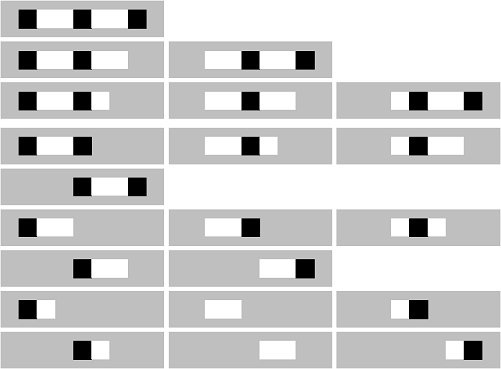
で、これらをさらに一つずつcenterになるかを考えて、W を得たいところだけど、面倒。なので、近似な W を考えることにする。どうやるかっていうと、local symmetryじゃないのは取り除くことにする。で、残ったのが以下の7つ。
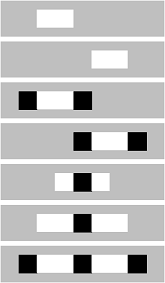
最終的には、これら7つがcenterってことになって、R でのWsymmとなる。
他の引用。
What I call the wholeness is, to a very rough degree, a mathematical representation of the overall gestalt which we perceive, or which we are aware, which gives the character to the configuration, and which forms, what an artist might call, his most intuitive apperception of the whole.他の引用。
I propose a view of physical reality which is dominated by the existence of this one particular structure, W, the wholeness. In any given region of space, some subregions have higher intensity as centers, others have less. Many subregions have weak intensity or none at all. The overall configuration of the nested centers, together with their relative intensities, comprise a single structure. I define this structure as "the" wholeness of that region.他の引用。
The essence of the wholeness, as I defined it, is neutral: it simply exists.
centerって何なの?
I call the most coherent subregions of R, centers. A region will be considered more or less centered according to its life. The most coherent subregions Si, which have a ci close to 1, will be called the centers of R. Even among centers, there are still degrees of relative life -- some are more coherent than others -- but all of them establish, through their life, a phenomenon of centeredness in space.R の各サブ領域Siがcenterになりうるという感じだな。ここでは、Siにciが割り当てられているとしてるんだ。で、cが1に近いSをcenterと呼んでるわけだな。
あと、centerの集合がwholenessを構成することになる。
他の引用。
[...] When I use the word center, I am always referring to a physical set, a distinct physical system, which occupies a certain volume in space, and has a special marked coherence. [...]
centerのその他の特徴
他の引用。
- Centers themselves have life.
- Centers help one another: the existence and life of one center can intensify the life of another.
- Centers are made of centers (this is the only way of describing their composition).
- A structure gets its life according to the density and intensity of centers which have been formed in it.
The crux of the matter is this: a center is a kind of entity which can only be defined in terms of other centers. The idea of a center cannot be defined in terms of any other primitive entities except centers.他の引用。
To understand the idea of a center and its recursion deeply, it is necessary to learn to see each center as a field. What makes a center "centered" is that it somehow functions as an organized field of force in space. it has a structure of centrality, it communicates centrality, it creates a spatial feeling of centrality.
lifeって何なの?
[...] The key idea in this book is that life is structural. It is a quality which comes about because of the existence of a discernible structure in the wholeness -- and therefore explains what we perceive as the quality of building and artifacts. The structure is something I shall later define as "living structure."
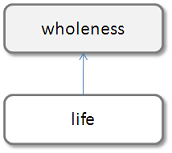
あるcenterが他のcenterを助けるとかってどいうことなの?
[...] Suppose we have two centers A and B, and we want to know if B is helping A or not. We simply look at A with B, and without B and go back and forth between the two, using the criterion of life to decide which of the two, A with B with out B, has more life. If, of the two, A with B has more life, then B is helping A.
各centerは、自身のdegree of lifeを持つらしいけど?
Armed with the idea that each center is a multilevelled field-like phenomenon made of other centers, let us now come back to the idea that each center has its degree of life.
living structureて何?
We may summarize the action of this field by means of a definition which is explicitly recursive: Each center is a field of other centers. By this definition, each of these other centers must then also be a field of centers. Thus a center is a field of centers, and within that field each center is a field of yet other centers. There are no ultimate elementary components of the field, except the centers themselves.This is the foundation of what I mean by living structure. [...]
living structureとunfolded structureの違いは?
The two conceptions of structure turn out to be complementary. In the end we shall see that living structure and unfolded structure are equivalent. All living structure is unfolded and all unfolded structure is living. And I believe the concept of an unfolded structure is as important, and should play as essential a role in architecture, as the concept of living structure. Thus we shall end up with two equivalent views -- one static, one dynamic -- of the same idea.
living processて何?
[...] I shall define a living process as any process that is capable of generating living structure. [...]living structureを生成できるなら、どんなプロセスでも、という感じだな。
他の定義。
We are ready to examine the general nature of all living process, and to give a definition of living process in the world of building. Let us define as follows: A living process is any adaptive process which generates living structure, step by step, through structure-preserving transformations.
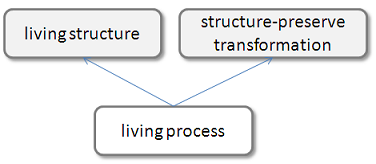
structure-preserving transformationって何なの?
What does it mean to say that a process is "smooth?" I define a smooth transformation as a transformation which preserves structure and wholeness: and from now on I shall refer to these types of transformation as structure-preserving transformations. [...]
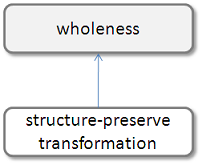
unfolding wholenessの原理って何?
パターンとcenterってどんな関係なの?
vol.2 の13章のタイトルはこう「Patterns: Generic Rules for Making Centers or "Making Life Enjoyable"」
centerにパターンの概念が依存してそうなことが分かるな。
[...] A pattern language is essentially a way of defining generic centers, and then using them, sequentially, in design projects. The entities we called patterns were -- albeit in an early formulation -- somewhat similar to the entities I now call centers. One might say that every pattern which was defined under that theory was, in effect, a rule for making or partly making some important type of center, necessary to the life of a living human environment.単にcenterと呼ばずにgeneric centerと呼んでいる点に注意が必要だな。
他の部分の引用。
One might say that every new pattern defined under the theory of pattern languages is a rule for creating a certain type of (new) living center, needed and appropriate in a given range of context. More precisely, one may express the relationship of the two theories like this: Each pattern is a rule which describes a type of strong center that is likely to be needed, on a recurring basis, throughout a particular environment or class of environments. Further, a pattern not only describes a recurring center, but also describes a relation between other generic centers. The pattern both describes a generic center, and describes a generic relation among other generic centers. But it must be remembered that the pattern describes a generic center, not a particular center. In this sense the pattern is not so much like an element in erector set, but more a rule for making a certain kind of center capable of making an infinite number of particular centers of same type, whenever they are needed.
重要だと思う点だけ。
さて、ソフトウェアパターンなど、建築でのパターンでないパターンは、少し考える必要性が出るかもしれないな。centerは物理的な空間での特定の領域を指す概念だからな。
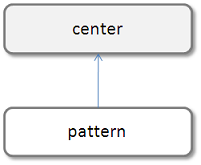
参考文献とリソース
更新履歴
todo/memo